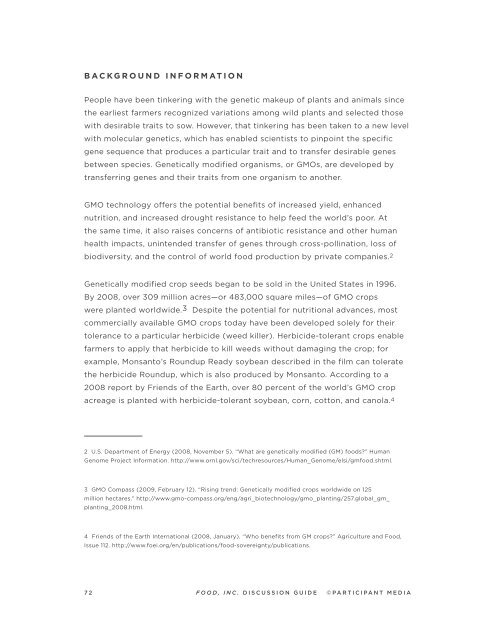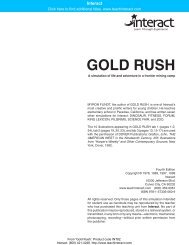Food, Inc. Discussion Guide - TakePart
Food, Inc. Discussion Guide - TakePart
Food, Inc. Discussion Guide - TakePart
- No tags were found...
You also want an ePaper? Increase the reach of your titles
YUMPU automatically turns print PDFs into web optimized ePapers that Google loves.
B a c k g r o u n d I n f o r m at i o nPeople have been tinkering with the genetic makeup of plants and animals sincethe earliest farmers recognized variations among wild plants and selected thosewith desirable traits to sow. However, that tinkering has been taken to a new levelwith molecular genetics, which has enabled scientists to pinpoint the specificgene sequence that produces a particular trait and to transfer desirable genesbetween species. Genetically modified organisms, or GMOs, are developed bytransferring genes and their traits from one organism to another.GMO technology offers the potential benefits of increased yield, enhancednutrition, and increased drought resistance to help feed the world’s poor. Atthe same time, it also raises concerns of antibiotic resistance and other humanhealth impacts, unintended transfer of genes through cross-pollination, loss ofbiodiversity, and the control of world food production by private companies. 2Genetically modified crop seeds began to be sold in the United States in 1996.By 2008, over 309 million acres—or 483,000 square miles—of GMO cropswere planted worldwide.3 Despite the potential for nutritional advances, mostcommercially available GMO crops today have been developed solely for theirtolerance to a particular herbicide (weed killer). Herbicide-tolerant crops enablefarmers to apply that herbicide to kill weeds without damaging the crop; forexample, Monsanto’s Roundup Ready soybean described in the film can toleratethe herbicide Roundup, which is also produced by Monsanto. According to a2008 report by Friends of the Earth, over 80 percent of the world’s GMO cropacreage is planted with herbicide-tolerant soybean, corn, cotton, and canola. 42 U.S. Department of Energy (2008, November 5). “What are genetically modified (GM) foods?” HumanGenome Project Information. http://www.ornl.gov/sci/techresources/Human_Genome/elsi/gmfood.shtml.3 GMO Compass (2009, February 12). “Rising trend: Genetically modified crops worldwide on 125million hectares.” http://www.gmo-compass.org/eng/agri_biotechnology/gmo_planting/257.global_gm_planting_2008.html.4 Friends of the Earth International (2008, January). “Who benefits from GM crops?” Agriculture and <strong>Food</strong>,Issue 112. http://www.foei.org/en/publications/food-sovereignty/publications.7 2F o o d , I n c . D I S C U S S I O N G U I D E© P a r t i c i p a n t M e d i a
















